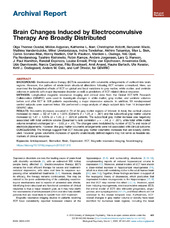Brain changes induced by electroconvulsive therapy are broadly distributed
| dc.contributor.author | Ousdal, Olga Therese | en_US |
| dc.contributor.author | Argyelan, Miklos | en_US |
| dc.contributor.author | Narr, Katherine L. | en_US |
| dc.contributor.author | Abbott, Christopher | en_US |
| dc.contributor.author | Wade, Benjamin | en_US |
| dc.contributor.author | Vandenbulcke, Mathieu | en_US |
| dc.contributor.author | Urretavizcaya, Mikel | en_US |
| dc.contributor.author | Tendolkar, Indira | en_US |
| dc.contributor.author | Takamiya, Akihiro | en_US |
| dc.contributor.author | Stek, Max L. | en_US |
| dc.contributor.author | Soriano-Mas, Carles | en_US |
| dc.contributor.author | Redlich, Ronny | en_US |
| dc.contributor.author | Paulson, Olaf B. | en_US |
| dc.contributor.author | Oudega, Mardien L. | en_US |
| dc.contributor.author | Opel, Nils | en_US |
| dc.contributor.author | Nordanskog, Pia | en_US |
| dc.contributor.author | Kishimoto, Taishiro | en_US |
| dc.contributor.author | Kämpe, Robin | en_US |
| dc.contributor.author | Jørgensen, Anders | en_US |
| dc.contributor.author | Hanson, Lars G. | en_US |
| dc.contributor.author | Hamilton, J. Paul | en_US |
| dc.contributor.author | Espinoza, Randall | en_US |
| dc.contributor.author | Emsell, Louise | en_US |
| dc.contributor.author | van Eijndhoven, Philip | en_US |
| dc.contributor.author | Dols, Annemieke | en_US |
| dc.contributor.author | Dannlowski, Udo | en_US |
| dc.contributor.author | Cardoner, Narcis | en_US |
| dc.contributor.author | Bouckaert, Filip | en_US |
| dc.contributor.author | Anand, Amit | en_US |
| dc.contributor.author | Bartsch, Hauke | en_US |
| dc.contributor.author | Kessler, Ute | en_US |
| dc.contributor.author | Ødegaard, Ketil Joachim | en_US |
| dc.contributor.author | Dale, Anders | en_US |
| dc.contributor.author | Oltedal, Leif | en_US |
| dc.date.accessioned | 2020-05-19T15:53:41Z | |
| dc.date.available | 2020-05-19T15:53:41Z | |
| dc.date.issued | 2020-03-01 | |
| dc.Published | Ousdal OT, Argyelan M, Narr KL, Abbott C, Wade, Vandenbulcke M, Urretavizcaya, Tendolkar I, Takamiya, Stek ML, Soriano-Mas C, Redlich R, Paulson OB, Oudega ML, Opel N, Nordanskog P, Kishimoto, Kämpe R, Jørgensen A, Hanson LG, Hamilton JP, Espinoza R, Emsell L, van Eijndhoven P, Dols A, Dannlowski U, Cardoner, Bouckaert F, Anand A, Bartsch H, Kessler U, Ødegaard KJ, Dale A, Oltedal L. Brain changes induced by electroconvulsive therapy are broadly distributed. Biological Psychiatry March 1, 2020; 87(5):451–461 | eng |
| dc.identifier.issn | 1873-2402 | |
| dc.identifier.issn | 0006-3223 | |
| dc.identifier.uri | https://hdl.handle.net/1956/22306 | |
| dc.description.abstract | Background Electroconvulsive therapy (ECT) is associated with volumetric enlargements of corticolimbic brain regions. However, the pattern of whole-brain structural alterations following ECT remains unresolved. Here, we examined the longitudinal effects of ECT on global and local variations in gray matter, white matter, and ventricle volumes in patients with major depressive disorder as well as predictors of ECT-related clinical response. Methods Longitudinal magnetic resonance imaging and clinical data from the Global ECT-MRI Research Collaboration (GEMRIC) were used to investigate changes in white matter, gray matter, and ventricle volumes before and after ECT in 328 patients experiencing a major depressive episode. In addition, 95 nondepressed control subjects were scanned twice. We performed a mega-analysis of single subject data from 14 independent GEMRIC sites. Results Volumetric increases occurred in 79 of 84 gray matter regions of interest. In total, the cortical volume increased by mean ± SD of 1.04 ± 1.03% (Cohen’s d = 1.01, p < .001) and the subcortical gray matter volume increased by 1.47 ± 1.05% (d = 1.40, p < .001) in patients. The subcortical gray matter increase was negatively associated with total ventricle volume (Spearman’s rank correlation ρ = −.44, p < .001), while total white matter volume remained unchanged (d = −0.05, p = .41). The changes were modulated by number of ECTs and mode of electrode placements. However, the gray matter volumetric enlargements were not associated with clinical outcome. Conclusions The findings suggest that ECT induces gray matter volumetric increases that are broadly distributed. However, gross volumetric increases of specific anatomically defined regions may not serve as feasible biomarkers of clinical response. | en_US |
| dc.language.iso | eng | eng |
| dc.publisher | Elsevier | eng |
| dc.rights | Attribution CC BY-NC-ND | eng |
| dc.rights.uri | http://creativecommons.org/licenses/by-nc-nd/4.0/ | eng |
| dc.subject | Antidepressant | eng |
| dc.subject | Biomarker | eng |
| dc.subject | Brain | eng |
| dc.subject | Depression | eng |
| dc.subject | ECT | eng |
| dc.subject | Magnetic resonance imaging | eng |
| dc.subject | Neuroimaging | eng |
| dc.title | Brain changes induced by electroconvulsive therapy are broadly distributed | en_US |
| dc.type | Peer reviewed | |
| dc.type | Journal article | |
| dc.date.updated | 2020-02-04T20:21:26Z | |
| dc.description.version | publishedVersion | en_US |
| dc.rights.holder | Copyright 2019 Society of Biological Psychiatry | |
| dc.identifier.doi | https://doi.org/10.1016/j.biopsych.2019.07.010 | |
| dc.identifier.cristin | 1745407 | |
| dc.source.journal | Biological Psychiatry |

